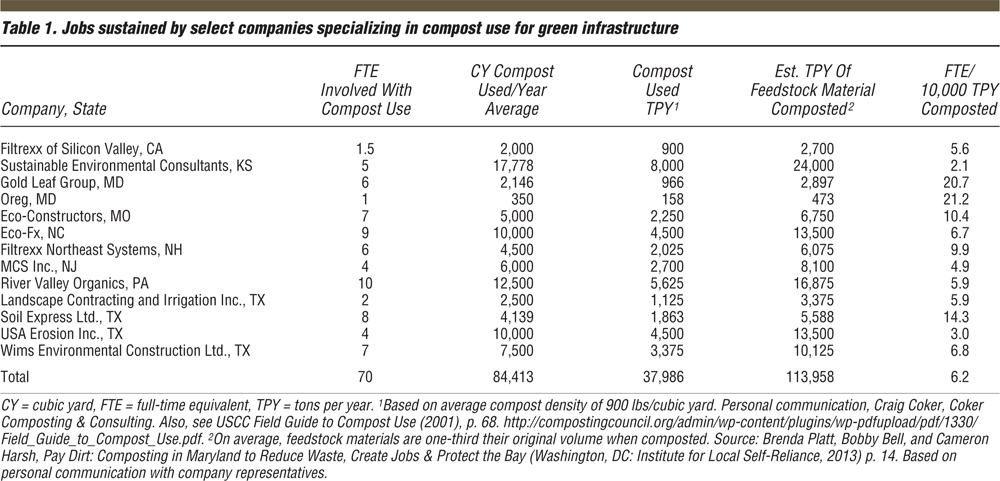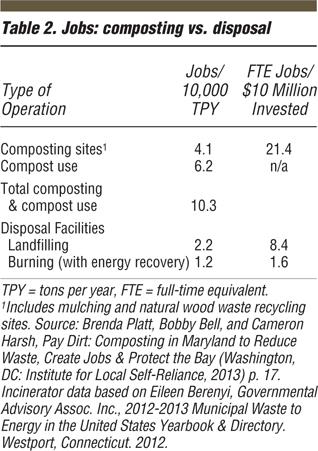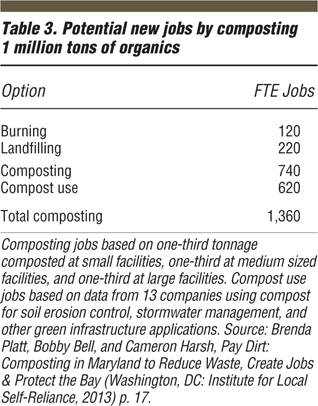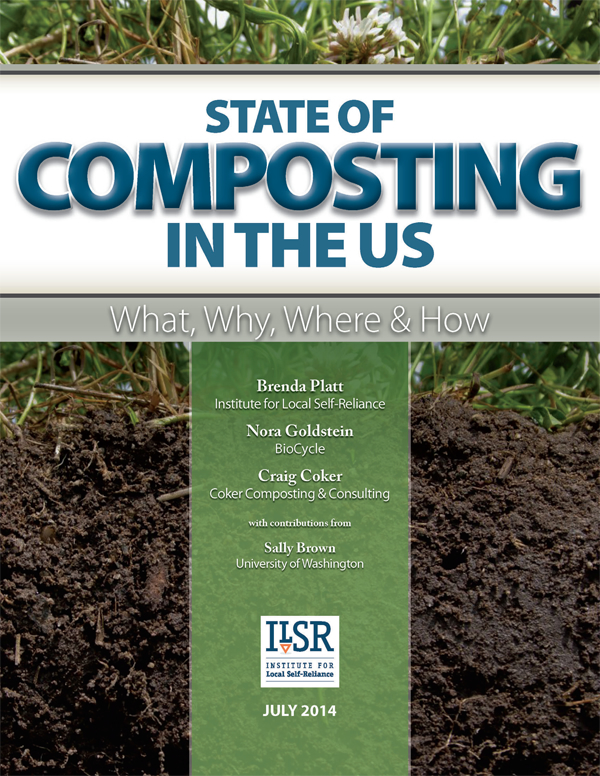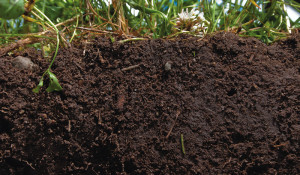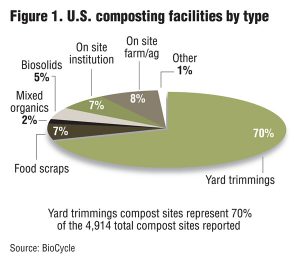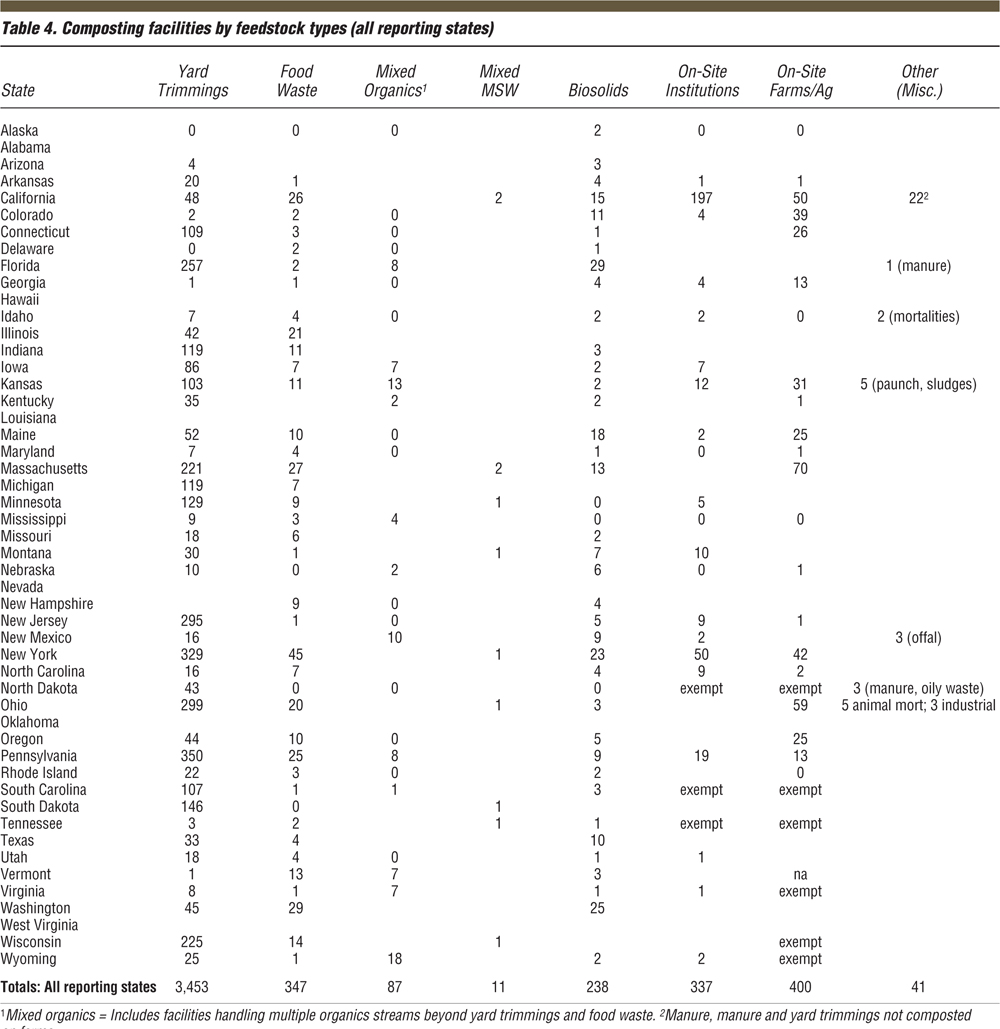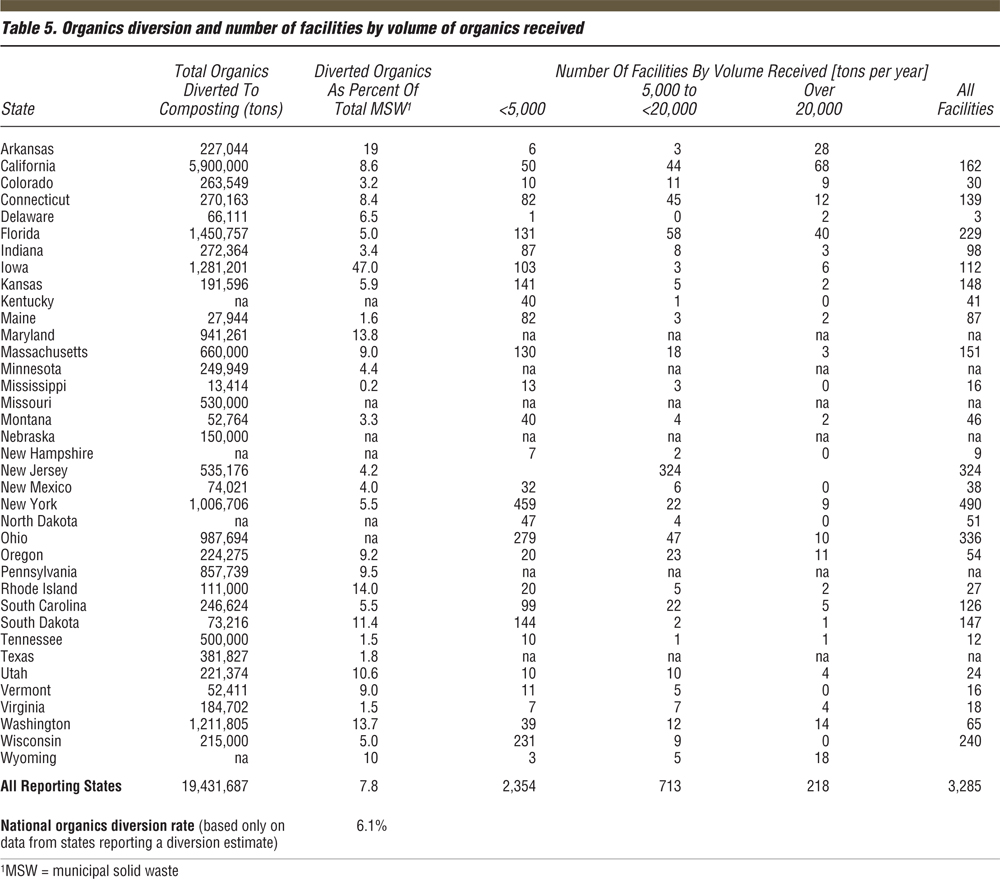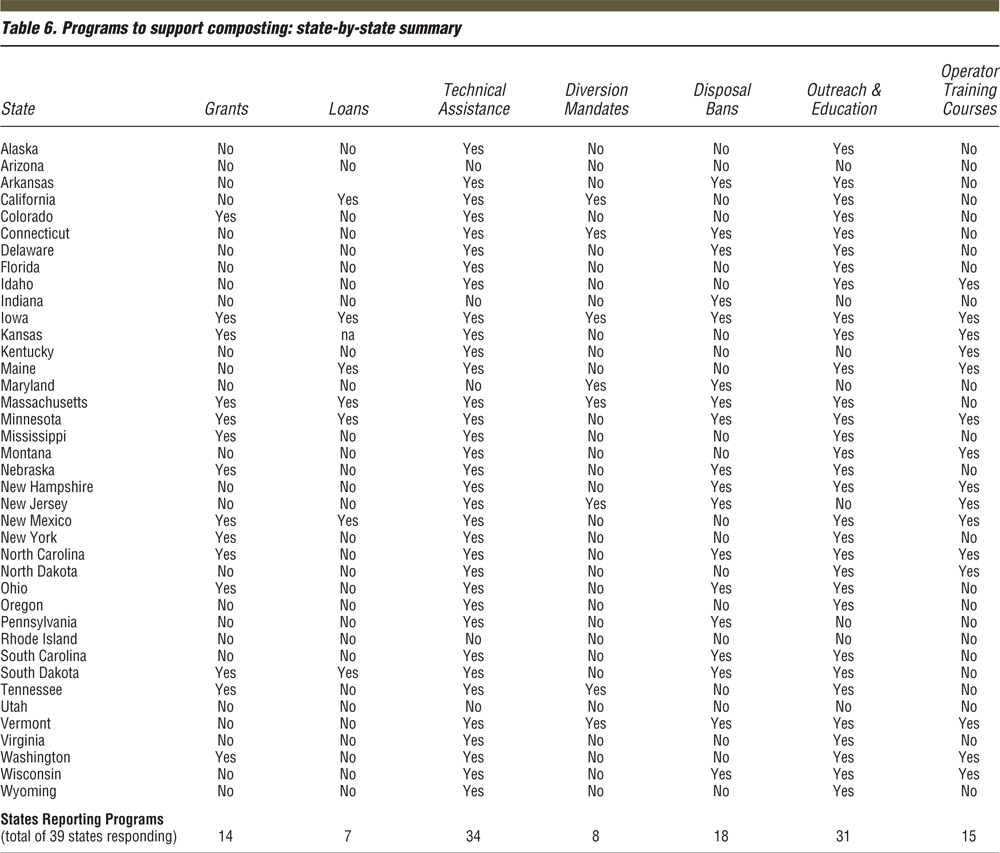New report reviews composting basics, provides national and state-by-state statistics and job generation data, summarizes model programs, technologies and systems, and concludes with recommendations on how to grow composting in the U.S.
Brenda Platt and Nora Goldstein
BioCycle July 2014
The benefits of composting are well documented. Compost is a valuable soil conditioner. It adds needed organic matter, sequesters carbon, improves plant growth, conserves water, reduces reliance on chemical pesticides and fertilizers, and helps prevent nutrient runoff and erosion. Composting also reduces the volume of materials that might otherwise be disposed in landfills or trash incinerators, and repurposes these materials through recycling. It is a place-based industry, which cannot be outsourced abroad. Thus, advancing composting and compost use in the U.S. is a key sustainability strategy to create jobs, protect watersheds, reduce climate impacts, improve soil vitality, and build resilient local economies.
With all these benefits, why aren’t we composting more? How can we generate and use more compost to sequester carbon in soil and improve soil structure and fertility? Where can the compost come from? What kinds of systems are the most effective? What types should be promoted? What are the threats to expanding composting? What are its limitations? What infrastructure and policies are needed to advance composting? How do we do implement these?
To answer these questions, the Institute for Local Self-Reliance has coauthored a new report, State of Composting in the U.S.: What, Why, Where & How, with Nora Goldstein (BioCycle), Craig Coker (Coker Composting & Consulting) and Sally Brown (University of Washington). The report explains what composting is and why it is important; summarizes model programs, technologies and systems; and provides a national and state-by-state snapshot of activities, infrastructure needed, and policy opportunities. It concludes with recommendations on how to grow composting in the U.S.
This article provides highlights from State of Composting in the U.S., specifically new data on job creation benefits of composting and compost use, updated information on state infrastructure and programs, and key policies for advancing composting.
State of Composting in the U.S. can be downloaded at ilsr.org/initiatives/composting
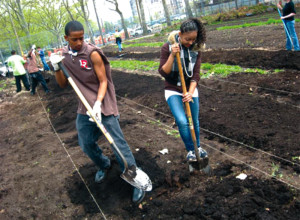
Community farms and composting sites can house job training programs, such as this one at Red Hook Community Farm in Brooklyn, New York. Photo courtesy of Red
Hook Community Farm
Why Compost?
For the Soil
Improving soil and protecting watersheds are two key drivers of why we need more composting. One-third of the world’s arable land has been lost to soil erosion and continues to be lost at an alarming rate (Zang and Wang, 2006). In the U.S., 99 million acres (28% of all cropland) are eroding above soil tolerance rates, meaning the long-term productivity of the soil cannot be maintained and new soil is not adequately replacing lost soil (NRCS, 2007). Erosion reduces the ability of soil to store water and support plant growth. Amending soil with compost improves soil quality and structure, increases water retention, reduces chemical needs, and cuts nonpoint source pollution.
For Jobs
Like reuse and recycling, composting offers direct development opportunities for communities. Whether on a per-ton basis or on a per-dollar-capital investment basis, composting sustains more jobs than other waste handling options such as landfilling and incineration. But unlike linear disposal systems, composting is ultimately a manufacturing enterprise that produces a value-added product for multiple end markets where jobs are sustained in each phase of the organics recovery cycle. In addition to the direct jobs at composting facilities, use of compost supports new green enterprises and additional jobs. Most of the end markets for compost tend to be regional, if not local. Each recycling step a community takes locally means more jobs, more business expenditures on supplies and services, and more money circulating in the local economy through spending and tax payments.
More than 15 years ago, ILSR conducted extensive research on the jobs sustained by reuse, recycling and composting. On a per-ton basis, the research found that composting sustains four times the number of jobs as landfill or incinerator disposal (Platt and Seldman, 2000). While a few studies have since been released evaluating jobs and recycling, ILSR’s per-ton job factors have not been updated and little data exists documenting the jobs through composting. In 2013, ILSR evaluated the current and potential composting-related jobs in Maryland. This study, Pay Dirt: Composting in Maryland to Reduce Waste, Create Jobs & Protect the Bay, found:
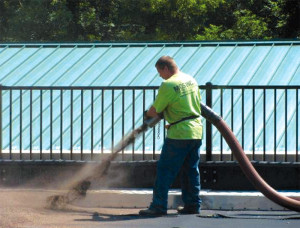
An entire new industry of contractors who use compost and compost-based products for green infrastructure (such as green roofs, above) has emerged, creating job opportunities. Photo courtesy of MCS Inc.
• Composting (including mulching and natural wood waste recycling) operations in Maryland already sustain more total jobs than the state’s three trash incinerators, which handle almost twice as much tonnage.
• On a per-ton basis, composting in Maryland employs two times more workers than landfilling, and four times more than the state’s trash incinerators.
• On a per-dollar-capital investment basis, for every $10 million invested, composting facilities in Maryland support twice as many jobs as landfills and 17 more jobs than incinerators.
• An entire new industry of contractors who use compost and compost-based products for green infrastructure has emerged, presenting an opportunity to establish a new made-in-America industrial sector, creating even more jobs.
• Utilizing 10,000 tons of finished compost annually in green infrastructure can sustain one new business. For every 10,000 tons of compost used annually by these businesses, 18 full-time equivalent jobs can be sustained.
Table 1 presents employment data for 13 companies, spanning Maryland to California, that specialize in using compost for green infrastructure (e.g., bioswales, green roofs, green streets, rain gardens). These 13 companies together employ 70 workers involved with using approximately 38,000 tons per year of compost (84,000 cubic yards of material). In other words, they sustain ~18 positions per 10,000 tons of compost they use each year (or 6 positions per 10,000 tons of raw materials composted).
Table 2 compares job creation benefits of both composting and compost use compared to disposal options in Maryland. When taking into account the potential jobs that could be sustained by utilizing compost in-state for green infrastructure, on a per-ton basis, composting and compost use would sustain five times more jobs than landfilling and nine times more jobs than incineration.
Based on ILSR’s research for Maryland, for every one million tons of organic materials composted (and not disposed) at a mix of small, medium and large facilities — with the resulting compost used in-state — almost 1,400 new full-time equivalent jobs could potentially be supported, paying wages ranging from $23 million to $57 million. In contrast, when disposed in Maryland’s landfills and incinerators, this tonnage only supports 120 to 220 jobs (Table 3).
National Snapshot
What is the State of Composting in the U.S.? In a nutshell, municipal and county governments, as well as private food scrap generators, increasingly recognize the importance of diverting yard trimmings and food scraps from disposal to reach recycling goals and manage solid waste handling costs. However, while recovery of yard trimmings is well established, infrastructure for composting food scraps lags behind.
Data collection methods used by BioCycle are explained in an accompanying sidebar. Of the 4,914 composting operations identified in the U.S. for this study, about 71 percent compost only yard trimmings (based on 44 states reporting.) The totals are divided as follows (Table 4): Yard trimmings: 3,453; Food waste: 347; Mixed organics (combinations of various organic waste streams): 87; Mixed waste composting (unsorted solid waste): 11; Biosolids: 238; Composting on site at institutions: 337; Composting on site on farms/agricultural operations: 400; Miscellaneous: 41. Figure 1 shows a breakdown by type. Food scrap recovery is slowly growing. More than 180 communities have instituted residential food scrap collection programs, up from only a handful a decade ago. Countless supermarkets, schools, restaurants and other businesses and institutions are also source separating their food scraps for composting. But the current infrastructure remains inadequate.
State organics recycling officials contacted as part of this project were asked for the total tons of organics diverted to composting and to tally the number of composting facilities in their state by volume of material processed. Thirty-three of the 44 responding states were able to provide a quantity — a total of 19,431,687 tons of organics diverted to composting (Table 5). The organic waste streams primarily consist of yard trimmings, food scraps, biosolids and some agricultural waste streams, including manure. Of the states reporting, California had the highest composting tonnage in 2012 (5.9 million tons); Florida had the second highest (1.5 million tons), followed by Iowa (1.3 million tons), Washington State (1.2 million tons) and New York (1.0 million tons).
State officials contacted were asked to tally the number of composting facilities in their state by volume of material processed (i.e., processing capacity). Three capacity ranges were provided: <5,000 tons/year; 5,000 to <20,000 tons/year; and >20,000 tons/year. A response to this requested breakdown was provided by 31 states: 72% of the 3,285 composting facilities (2,354) in those 31 states are composting less than 5,000 tons/year of materials (Table 5). There are 713 facilities in the 5,000 to 20,000 tons/year range. Only 218 facilities are composting more than 20,000 tons/year. States responding to this inquiry include heavily populated states such as California, Florida, Massachusetts, New Jersey, New York, Ohio, Virginia and Washington.
As shown in Table 5, 27 of those 31 states also reported the total amount of organics diverted to composting in 2012. In total, those 27 states diverted 16,321,000 tons of organics to composting at 3,166 facilities (the total of 3,285 less the 119 facilities in the four states that did not provide a total amount of organics diverted to composting). That is an average of 5,155 tons/facility/year. This is far too small. To achieve higher levels of composting in the U.S., more processing capacity will be needed.
State Programs To Support Composting
Aside from some grant funds available from the U.S. Department of Agriculture/Natural Resources Conservation Service for on-farm composting sites for equipment and some infrastructure via its EQIP program (Environmental Quality Incentives Program: www.nrcs.usda.gov/wps/ portal/nrcs/main/ia/programs/financial/eqip/), there are no federal grant or loan programs for composting facilities. About 25 years ago, in anticipation of closure of substandard landfills under the then new Subtitle D regulations, states started getting proactive about establishing composting infrastructure, especially for yard trimmings. This is the timeframe when over 20 states adopted some type of disposal ban on yard trimmings (mostly between 1988 and 1996). As part of being proactive, state legislatures passed recycling goals, and state solid waste management agencies established grant and educational programs, and hired staff to service those programs and offer technical assistance. In many states, grants were funded by a per ton surcharge on municipal solid waste disposed.
Fast forward to today, and the picture is much different. That push to build composting and recycling infrastructure lasted through most of the 1990s, but then started to wane —
especially as large, regional Subtitle D-compliant landfills replaced local landfills. Trash began flowing long distances by rail and truck, a scenario that still exists today. The U.S. has no shortage of landfill capacity, although some individual states, e.g., Massachusetts, are running out. While some states still have recycling or waste diversion goals or mandates, only California actually has a mechanism to fine noncompliant jurisdictions.
BioCycle’s snapshot questionnaire asked states to provide an update on their programs to support composting. As can be seen in Table 6, states were asked to provide yes/no answers (i.e., if these programs exist) to the following categories: Grants; Loans; Technical assistance; Diversion mandates; Disposal bans; Outreach and education; and Operator training courses. Only 14 of the 39 states reporting have a grant program, and only 7 have a loan program. Most
of the states reporting (34 of 39) provide technical assistance. Only 9 states have diversion mandates, and 18 of the 39 indicate their state has a disposal ban. Thirty-one states have outreach and education programs, and 15 states offer operator training courses.
This lack of funding via grants and loans to help establish or expand composting infrastructure is discouraging in light of the critical need for more organics processing capacity in the U.S. In addition, many states have cut the number of full-time employees dedicated to composting, i.e., state organics recycling specialists often are given other programs to manage that are unrelated to composting and organics management. The Ohio Environmental Protection Agency and the California Department of Resources Recycling and Recovery (CalRecycle) stand out as two exceptions to this trend. Massachusetts, which is getting ready to enforce its commercial organics disposal ban in fall 2014, has contracted out much of its technical assistance for composting, so has not added staff at the agency level.
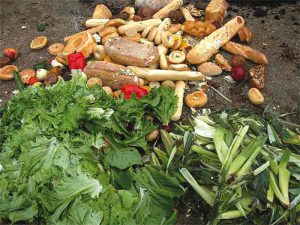
One opportunity to create more infrastructure for food scrap composting is to utilize existing yard trimmings composting facilities. Photo courtesy of Institute for Local Self-Reliance
Yard Trimmings And Food Scraps
At the state level, policies have been enacted to encourage or require diversion of source separated organics. Over 20 states enacted bans on disposal of yard trimmings in landfills many years ago. More recently, a handful of states have established food waste disposal bans. How effective are bans at driving diversion to composting? In general, it is widely accepted that state yard trimmings disposal bans have reduced the amount of yard trimmings flowing to landfills, especially the stronger bans. But disposal bans are certainly not the only mechanism for driving composting. Of the top five states in terms of diversion of organics to composting, only Iowa has a ban on disposal of yard trimmings in landfills. California’s waste diversion goal has been effective at establishing local organics diversion programs — for both yard trimmings and food scraps.
The ability of a ban to drive further establishment of composting (and anaerobic digestion) infrastructure will be put to the test over the next several years, especially in Massachusetts where the state’s commercial organics disposal ban did not set a “proximity rule” for compliance, i.e., where food waste generators only need to comply if there is a permitted (or exempt for permitting) composting facility within 20 miles of their establishment(s) as is the case in Connecticut and Vermont (at this juncture).
One opportunity to create more infrastructure for food scrap composting is to utilize existing yard trimmings composting facilities. However, many of the 3,453 yard trimmings composting operations in the U.S. are not staffed or equipped to comply with requirements for receiving food scraps, nor are the materials receiving and composting pads adequate to manage incoming feedstocks with higher moisture content. And many of these operations are municipally-owned and operated, with constrained budgets and staff to alter operations to process food scraps. As such, the expectation, at least for the foreseeable future, is that any significant expansion of composting capacity for source separated food scraps will be done by privately operated composting facilities. Some states have been proactive in revising their composting regulatory structure to streamline permitting of existing yard trimmings composting facilities that want to start processing food scraps. For example, Ohio revised its composting rules several years ago to aid in this transition.
How To Grow Composting In The U.S.
Every state in the union can increase the recovery of yard trimmings, food scraps and other organic materials. Many are actively doing so. Almost 20 states have or are in the process of revising their permitting regulations for composting facilities. Every state in the union can also increase its use of compost and, through purchasing policies and specifying best management practices, can encourage the production and utilization of high-quality compost for high-quality applications. We can also do better at monetizing the benefits of compost, such as its ability to sequester carbon in soils, in order to incentivize the industry.
New rules and policies are very effective means for growing composting. State of Composting in the U.S. outlines a menu of local and state policies that could be implemented to further composting and compost production. Also needed is financial modeling to provide valid data for investors and other interested parties. Training is critical to the success of composting, regardless of the facility size. The development of professional compost science, engineering and usage programs at state land-grant colleges in the U.S. could be funded to both raise the professionalism of the industry and to create a cadre of graduates that can help run and expand composting facilities.
Policy Opportunities
Local and state government policies are needed to overcome lack of infra-structure and other obstacles to diverting organic materials from disposal. What is currently missing in many existing policies is adequate recognition of the benefits of a decentralized and diversified infrastructure.
Composting can take place at many levels — backyard, block, neighborhood, schoolyard, community and regional — and in urban, suburban and rural areas. There are many methods and sizes. Large-scale centralized facilities can serve wide geographic areas and divert significant quantities of organic materials from disposal facilities. Composting locally at the neighborhood or community-scale yields many other benefits: improved local soils, more local jobs, greener spaces, enhanced food security and fewer food deserts, less truck traffic hauling garbage, and increased composting know-how and skills within the local workforce and reinforced in the next generation. When composting is small-scale and locally based, community participation and education can flourish.
ILSR recommends development of a composting strategy that promotes home composting and small-scale farm and community sites as a priority, followed by onsite institutional systems (particularly at schools) and then development of commercial capacity for remaining organics. There are countless farmers who could potentially start composting if they were trained and could navigate zoning and other regulations. Expansion of backyard composting would reduce municipal government costs to collect and handle material and retain valuable organic matter in neighborhood soils.
At the state level, some critical policies include those that establish minimum recycling goals, adopt highest and best use hierarchies, implement per-ton surcharges on disposal facilities, create moratoriums on building new trash incinerators, and ban yard trimmings and/or commercial organics from landfills and incinerators. Other important categories include state composting infrastructure development policies, state compost usage encouragement policies, and statewide economic incentive policies.
The City of Austin may perhaps be unique in its official recognition of the benefits of a decentralized composting infrastructure. The Austin Resource Recovery Department (previously the Solid Waste Services Department) recognizes that, in addition to helping the City achieve its Zero Waste goals, composting also addresses the community’s interest in enriching the region’s soil, strengthening sustainable food production and completing the food cycle. As a result, the City has adopted a highest and best use philosophy for city collection programs of residential food scraps to guide its planning (City of Austin, 2011).
Additional public policy tools to increase composting and compost use in the U.S. are described in the accompanying sidebar.
National soils policy
Despite many compelling drivers, there are a number of obstacles to widespread implementation of composting. Despite best intentions, composting and compost use will ultimately be limited if disposal fees remain cheap, new trash incinerators are built (under the false guise of providing renewable energy), persistent herbicides remain on the market, and policies are not passed to support development of adequate infrastructure (small and large and everything in between).
In the absence of strong federal policy, local and state government can set specific food waste recovery goals, and they can tie their composting goals to soil health, watershed preservation, climate protection, waste reduction goals, and local economic development.
Perhaps nothing is more important to advancing composting and compost use than reinvigorating the movement to promote a national soils policy. In 1975, Jerry Goldstein, founder of BioCycle, suggested that a National Humus Program was vital: “As we enter the Bicentennial Year [1976], let’s suggest to our politicians and policy makers that we should include in the celebration the vow to build up the soil humus content of the nation with all kinds of organic wastes. Perhaps we can even get our candidates in 1976 to include a Humus Plank in their presidential platforms.”
Now, more than ever, it’s time to bring back Jerry Goldstein’s campaign for a National Soil Fertility Program. England has adopted a “soil strategy” that may be a model for the U.S. to emulate. Compost is recognized as an important method of increasing levels of organic matter in soil, reducing fertilizer requirements and diverting materials from landfill (DEFRA, 2009).
It is time to adopt a national soils strategy that institutionalizes the role of healthy soils — achieved by adding organic matter such as compost — as a tool to manage the harsh effects of climate change as well as sequester carbon. The U.S. has millions of acres of marginalized land starving for organic matter. Just applying a half-inch of compost per year to the 99 million acres of cropland eroding above soil tolerance levels would require about 3 billion tons of compost. There is not enough compost to meet this need. No organic scrap should be wasted.
Brenda Platt is Codirector of the Institute for Local Self-Reliance (www.ilsr.org) and Director of ILSR’s Composting Makes $en$e project. Nora Goldstein is Editor of BioCycle. State of Composting in the U.S. can be downloaded at ilsr.org/initiatives/composting.
